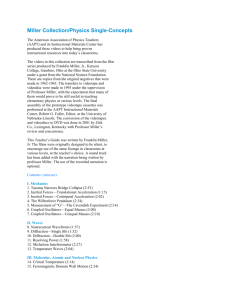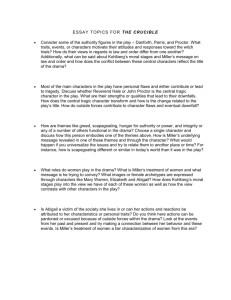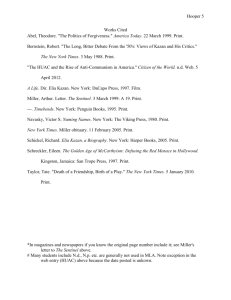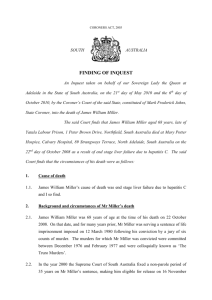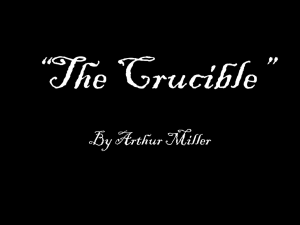MILLER Franklin Delano
advertisement
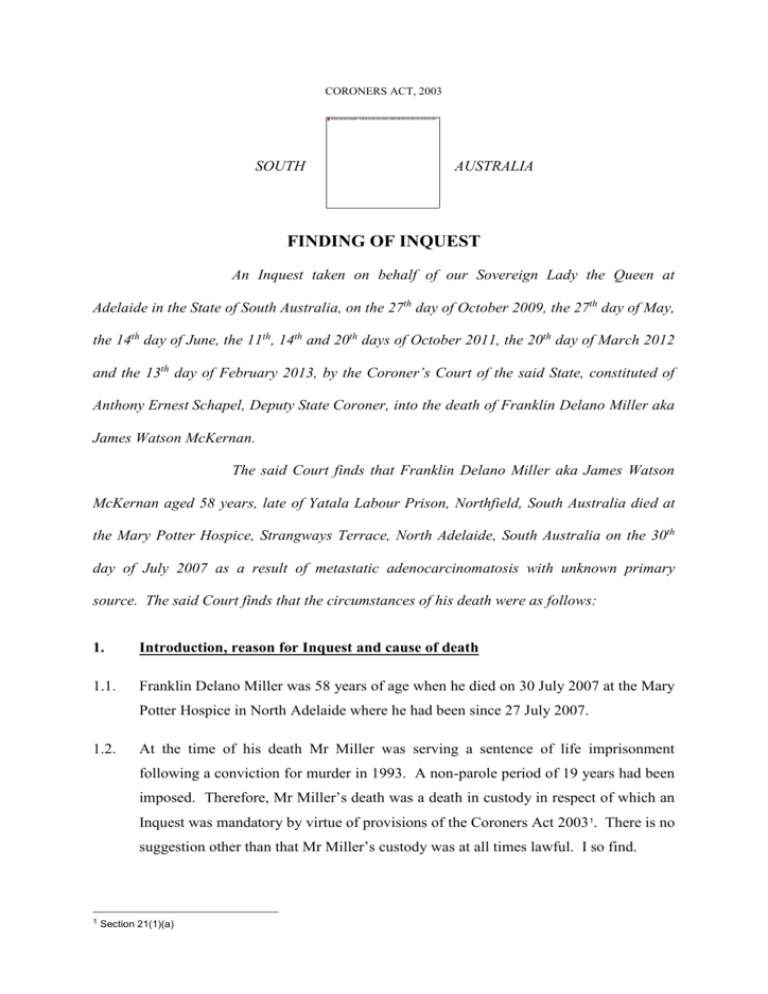
CORONERS ACT, 2003 SOUTH AUSTRALIA FINDING OF INQUEST An Inquest taken on behalf of our Sovereign Lady the Queen at Adelaide in the State of South Australia, on the 27th day of October 2009, the 27th day of May, the 14th day of June, the 11th, 14th and 20th days of October 2011, the 20th day of March 2012 and the 13th day of February 2013, by the Coroner’s Court of the said State, constituted of Anthony Ernest Schapel, Deputy State Coroner, into the death of Franklin Delano Miller aka James Watson McKernan. The said Court finds that Franklin Delano Miller aka James Watson McKernan aged 58 years, late of Yatala Labour Prison, Northfield, South Australia died at the Mary Potter Hospice, Strangways Terrace, North Adelaide, South Australia on the 30th day of July 2007 as a result of metastatic adenocarcinomatosis with unknown primary source. The said Court finds that the circumstances of his death were as follows: 1. Introduction, reason for Inquest and cause of death 1.1. Franklin Delano Miller was 58 years of age when he died on 30 July 2007 at the Mary Potter Hospice in North Adelaide where he had been since 27 July 2007. 1.2. At the time of his death Mr Miller was serving a sentence of life imprisonment following a conviction for murder in 1993. A non-parole period of 19 years had been imposed. Therefore, Mr Miller’s death was a death in custody in respect of which an Inquest was mandatory by virtue of provisions of the Coroners Act 2003 1. There is no suggestion other than that Mr Miller’s custody was at all times lawful. I so find. 1 Section 21(1)(a) 2 1.3. Mr Miller had been seriously ill with cancer which had been definitively diagnosed in June 2007. Investigations undertaken at the Royal Adelaide Hospital (RAH) in that same month revealed that he had widespread adenocarcinomatosis deposits in his bones and liver. The primary source of the cancer was not found at any time prior to Mr Miller’s death. 1.4. Mr Miller was receiving palliative, terminal care at the time of his death. 1.5. No post-mortem examination was conducted in respect of Mr Miller’s remains. A pathological review undertaken by Dr Iain McIntyre, as discussed with Dr Cheryl Charlwood, a forensic pathologist at Forensic Science South Australia, did not recommend an autopsy in respect of Mr Miller’s remains. Rather, Mr Miller’s clinical records were examined by Dr McIntyre and it was determined from those that the cause of his death was metastatic adenocarcinomatosis with unknown primary source2. I find that to have been the cause of Mr Miller’s death. 1.6. Although the cause of Mr Miller’s death is established, there are two matters that may have been more effectively elucidated by an autopsy. Firstly, although an opinion proffered by an independent expert oncologist suggests that the gastrointestinal tract may well have been the area of the body from which the cancer had spread, the primary source of the metastatic cancer that was evident in Mr Miller’s bones and liver was never positively determined. It probably would have been identified if an autopsy had been performed. Secondly, a lesion on Mr Miller’s liver that had been revealed radiologically several months before his death had not been the subject of a definitive diagnosis at that time or at all. Whether or not that lesion may have been identified post-mortem and have been the subject of a definitive diagnosis postmortem cannot now be known with absolute certainty, but the possibility remains that its nature may have been so determined. 1.7. In this Inquest I examined the cause and circumstances of Mr Miller’s death, and in particular the quality of the medical care that he had been afforded during the months prior to his death. 2 Exhibit C2a 3 2. Mr Miller’s incarceration and medical treatment 2.1. Mr Miller had a history of alcoholism and opioid dependence. He also suffered from what appears to have been chronic back pain. 2.2. At all material times Mr Miller was serving his sentence at the Port Lincoln Prison. The Port Lincoln Prison housed a medical clinic that was operated by and staffed with nurses employed by the Prison Health Service which is a Government entity, being an arm of the Department of Health. There were no full-time medical practitioners attached to the clinic. However, three medical practitioners who were members of a Port Lincoln medical practice known as the Investigator Clinic would periodically attend at the Port Lincoln Prison and would there consult with inmates seeking medical treatment. At the material time Mr Miller’s medical needs were met by Drs Peter Krige and Ian Toogood of the Investigator Clinic. Dr Krige is a general practitioner of several years standing both in South Africa and Australia. Dr Toogood is a consultant physician specialising in paediatric oncology and haematology. At one time he was the Director of the Paediatric Oncology Service at the Women’s and Children’s Hospital. At the time with which this Inquest concerned Dr Toogood practised as a general practitioner within the Investigator Clinic at Port Lincoln. Both doctors gave evidence at the Inquest. 2.3. A convenient starting point in discussing the circumstances of Mr Miller’s decline in health and ultimate demise is 19 September 2006. On that day Mr Miller underwent a number of blood tests that would reveal two abnormal findings, namely a very high blood sugar level and an extremely high liver enzyme result being a GGT figure of 2093 where normal is between 0 and 60. This result was seen by Dr Krige on 22 September 2006. Dr Krige told me in evidence that such a result could mean that there was an obstruction to the biliary outflow tract, but that in Mr Miller’s case it could be consistent with liver cancer or cancer of the pancreas3. The same blood result indicated that Mr Miller had diabetes. Dr Krige gave evidence that he did not believe he actually saw Mr Miller on 22 September 2006. However, he saw him on 13 October 2006 on which occasion he ordered a CT scan of the abdomen4. His reason for ordering this was the obstructive liver picture as illustrated by the abnormal 3 4 Transcript, page 80 Transcript, page 83 4 GGT result already referred to and the possibility that a CT scan might reveal abnormalities in the gallbladder or possibly cancer of the pancreas or liver. 2.4. The CT scan was conducted locally and was the subject of a written report dated 25 October 20065. The report expressed findings to the effect that while no pancreatic mass was identified, there was a rounded fluid density region measuring 27mm within hepatic segment 6 (of the liver) that appeared to represent a simple cyst. The report suggested that an ultrasound be performed. 2.5. On 3 November 2006 Mr Miller was seen at the prison by Dr Toogood who ordered an ultrasound investigation. The ultrasound report dated 1 December 20066 revealed that the lesion that had been seen on the CT scan was described as being in a different segment, namely segment 5, and that vessels were evident within a mass. Whereas the CT scan report had expressed a view that the lesion may have been a simple cyst, the ultrasound suggested that the lesion, while being indeterminate in nature, may have been solid. The report raised the possibility that the lesion was a haemangioma which, if biopsied for further confirmation, might give rise to a dangerous haemorrhage. The ultrasound report prepared by a radiologist Dr Gary Croft stated that a labelled red cell scan might be of value to determine if the lesion was in fact a haemangioma. It also suggested that further hepatobiliary specialist review take place. One of the registered nurses employed at the prison, Ms Catherine Wright, noted on a copy of the ultrasound report that it was seen by Dr Toogood on 8 December 2006. 2.6. Dr Toogood did in fact see Mr Miller personally on 8 December 2006. In respect of that consultation, Dr Toogood made the following notation in Mr Miller’s progress notes: 'Liver lesion indeterminate Suggest wait + see – Rpt CT Scan in 6-12/12' 7 Dr Toogood interpreted this as meaning that his strategy was to wait and see having regard to Mr Miller’s clinical condition and to repeat the CT scan in 6 to 12 months time. Dr Toogood explained in his evidence that while the ultrasound report ruled out a benign cyst, it did not rule out haemangioma, although his impression was that the 5 Exhibit C21, page 123 Exhibit C21, page 122 7 Exhibit C21, page 45 6 5 radiologist had thought that it was not typical of haemangioma. Nevertheless, the interpretation placed upon the report was that it recommended exclusion of haemangioma before any further action be taken. Dr Toogood told me in evidence that if the lesion was a haemangioma, it would be a benign lesion and would require no further consideration. However, if it were not a haemangioma, it would have required further investigation in order to determine what it was and, in particular, whether it was a liver tumour. Both the labelled red cell scan that was recommended to diagnose or eliminate haemangioma and a biopsy of the lesion in the event that the scan was negative for haemangioma, would have needed to have taken place in Adelaide as the necessary facilities for such investigations were not available in Port Lincoln. 2.7. I digress here to mention that it is said that there is a well known aversion on the part of some prisoners accommodated in the Port Lincoln prison to be subjected to unnecessary travel to Adelaide, due to the length of the journey and the uncomfortable conditions in which it would be undertaken. As well, prisoners might suffer a disadvantage by virtue of the fact that while they are away from Port Lincoln, they might lose whatever favourable accommodations arrangements, such as single cell occupancy, that they have garnered. Their accommodation upon return might not be as desirable. Mr Miller was said to be a case in point. In fact when an attempt was made to transport Mr Miller to Adelaide on 10 January 2007 for the purposes of a Parole Board hearing, he was unable to tolerate the journey and had to be brought back before they had reached Port Augusta. 2.8. I mention all of this because Dr Toogood gave evidence that when he saw Mr Miller on 8 December 2006, Mr Miller indicated an unwillingness to travel to Adelaide for the recommended further investigations. It will be observed from the extract in Mr Miller’s clinical record as set out above that Dr Toogood made no note of Mr Miller’s unwillingness to travel, the note being confined to the ‘wait and see’ plan and to a suggested repeat of the CT scan in 6 to 12 months’ time. Nevertheless, Dr Toogood assured me on his oath that Mr Miller indeed had been insistent that he did not want to go to Adelaide, that he did not want to undertake the vehicular ride there and did not relish the thought of being accommodated in Yatala Prison for the duration of any stay in Adelaide8. Dr Toogood said this: 8 Transcript, page 111 6 'Q. So you have a memory of seeing him on that day. A. Well, yeah, I do, because this is a fairly significant finding and it's just never my practice to ignore important information like that, and you know, when he says 'Well, you know, I'm not going to go to Adelaide', there's nothing further I can do from this end because the investigation, short of a laparotomy, can't proceed and that's a pretty big call when there are other less invasive investigations that could still be done.' 9 Notwithstanding Dr Toogood’s recognition of the significance of the ultrasound finding and what it might possibly have signified, he acknowledged that he probably did not say anything to Mr Miller about the possibility of cancer. He said that cancer was not ‘foremost’ in his mind at that stage and there were no symptoms to suggest that the man was seriously ill at the time of this consultation. Dr Toogood regarded the unexplained extremely high liver enzyme result from September 2006 as a matter of concern, but did not believe that malignancy was the only explanation for that. In cross-examination by Ms Kereru, counsel assisting, Dr Toogood conceded that malignancy had not been discounted and that to date there had been no explanation provided for the liver enzyme result, meaning that there was a question mark over two pathologies, not one10. Dr Toogood agreed that although that was the case, this difficulty was accommodated by the plan to review Mr Miller and to repeat the CT scan in 6 to 12 months, a strategy designed to detect whether there had been any change in the intervening period. Dr Toogood did not make any arrangement to repeat the blood tests. In this regard Dr Toogood referred to an issue that Dr Krige also referred to, and that is the undesirability of a lack of continuity of care rendered by privately practising doctors to clientele of the Prison Health Service. 2.9. It appears that Dr Toogood did not in any way question or challenge Mr Miller’s decision not to travel to Adelaide for the necessary tests, if that indeed was what Mr Miller had said. Dr Toogood suggested that had cancer been at the forefront of his mind, he might have been a little more forceful in saying that it would be in Mr Miller’s best interests to go to Adelaide and be further investigated11. Thus it cannot be said with complete certainty what Mr Miller’s attitude may have been if the possible direness of his condition had been spelt out to him. What questioning there was appears to have been confined to Dr Toogood wanting to know the reasons why Mr Miller would not go. Dr Toogood correctly stated that while he could recommend 9 Transcript, page 111 Transcript, page 113 11 Transcript, page 116 10 7 what his patient might do, he could not tell the patient what to do12. He also stated that he could ‘frighten the hell out of’ a patient if that is what he needed to do, but even then it was the patient’s decision as to whether he or she would undergo recommended diagnostic measures. As well, as I have already indicated, Dr Toogood’s position was that he did not regard cancer as a principal differential diagnosis at that stage. 2.10. The lack of any notation by Dr Toogood or by nursing staff of Mr Miller’s unwillingness to travel to Adelaide for the recommended examinations caused me a measure of concern. Dr Toogood rightly acknowledged that his failure to make a note about that was a serious omission13. While this is undoubtedly an accurate concession, it still raised a question in my mind as to whether or not Mr Miller had said what Dr Toogood ascribed to him by way of an indicated unwillingness to travel. 2.11. However, there was other evidence that in a general sense tended to support the notion that Mr Miller was at times resistant to medical intervention. For instance, he had repeatedly failed to provide a faecal sample that had been requested in respect of a medical investigation. Ms Veronica Richardson is a registered nurse employed by the Prison Health Service at the Port Lincoln Prison. She gave evidence in the Inquest. She recalled Mr Miller as a prisoner who did not look after his health and who was non-compliant with suggested treatments. As an example, she cited his refusal to provide the faecal sample. He would also, to her knowledge, trade prescribed medication to other prisoners. Ms Richardson told the Court that on numerous occasions she had explained to Mr Miller the desirability of his compliance with clinical requests. Ms Richardson also spoke of the general culture at the Port Lincoln Prison that involved prisoners refusing to undergo medical investigation or treatment in Adelaide because of their aversion to being accommodated at Yatala. As well, she confirmed that some prisoners regarded the overnight accommodation at Port Augusta Prison and the entire journey in uncomfortable conditions as things that they would want to avoid14. Additionally, they risked losing their favourable accommodation circumstances at Port Lincoln Prison. Ms Richardson stated that prisoners could not be forced to undergo medical treatment, which is true15. Ms Richardson could recall the incident in which Mr Miller was transferred to Adelaide 12 Transcript, page 145 Transcript, page 143 14 Transcript, page 48 15 Transcript, page 49 13 8 for the purposes of a parole hearing and suggested that his intolerance of the journey and the conditions under which it was undertaken meant that they were lucky that they did not “lose him” that day16. She did tell the Court that Mr Miller had no difficulty undergoing some examinations including CT scans and ultrasounds that were conducted locally, but that he was one of a number of prisoners who would not wish to travel to Adelaide. He eventually did travel when, in June 2007, the seriousness of his health situation became overwhelmingly evident to him. Ms Richardson acknowledged that Department for Correctional Services had the power to transfer a prisoner from Port Lincoln to Yatala, regardless of the prisoner’s wishes and regardless of the reason for the transfer, notwithstanding that the refusal of the prisoner to undergo medical treatment once they were in Adelaide had to be respected. 2.12. As to the need for Mr Miller to attend in Adelaide for investigation following his CT and ultrasound, in the normal course clinical staff at the prison would make the necessary appointment with the appropriate clinic in Adelaide and that the Department for Correctional Services would arrange the transport. There was, in the event, the ultimately aborted opportunity in January 2007 for Mr Miller to be transported to Adelaide for the purposes of a parole hearing, but Ms Richardson suggested that it may have been difficult to line up a medical appointment at short notice during the period in which he was in Adelaide for these purposes. 2.13. Ms Catherine Wright was also a registered nurse at the Port Lincoln Prison at the material time. Ms Wright was the nurse who had endorsed the ultrasound report as having been seen by Dr Toogood at his consultation on 8 December 2006. Ms Wright also recalled Mr Miller. In her evidence in the Inquest, Ms Wright also spoke of a reluctance by some prisoners at Port Lincoln to refuse to go to Adelaide for examinations or medical treatment for the same reasons identified by others. Ms Wright told the Court that in the face of such reluctance they would explain the pros and cons of the proposed examination in Adelaide. She mentioned the existence of a document that was used to record a refusal of medical treatment against advice. She suggested that Dr Toogood was aware of the existence of these forms, located certainly at the local hospital and possibly at the Prison Health Service as well17. In 16 17 Transcript, page 52 Transcript, page 195 9 any event no such form was executed in Mr Miller’s case and, as already alluded to, no record of Mr Miller’s reluctance to go was made within the clinical progress notes. 2.14. Ms Wright acknowledged that having regard to her endorsement of the ultrasound report, she must have been present at the prison clinic on 8 December 2006 when Dr Toogood saw Mr Miller. Ms Wright acknowledged that she was in the habit of reading such reports herself and that she therefore would have read the report in question18. She told the Court that although she would not necessarily have been present during Dr Toogood’s consultation of 8 December 2006, she acknowledged that she at least would have read Dr Toogood’s entry in the progress notes subsequent to the consultation. She acknowledged that Dr Toogood’s recorded plan to ‘wait and see’ and to repeat the CT scan in 6 to 12 months was not consistent with the recommendation in the ultrasound report that further specialist review be undertaken.19 She suggested that she probably would have taken that issue up with Dr Toogood, and in particular, to have asked him whether or not there was a need to organise a specialist appointment. If Dr Toogood had responded by saying that the patient did not want to undergo the investigations, she said: 'I probably, on hindsight, I probably should have documented it in the case notes.' 20 Ms Wright suggested that the lack of any such documentation or the lack of a release form was in this case probably an oversight on her part. 2.15. It was plain to the Court that Ms Wright did not have any specific recollection of the circumstances surrounding Dr Toogood’s consultation of 8 December 2006, the reason why the recommended investigations were not going to be carried out and the underlying basis for Dr Toogood’s plan to wait and see and review by way of CT scan in 6 to 12 months. She did have a recollection of the incident in January 2007 that involved Mr Miller’s aborted transfer from Port Lincoln to Adelaide. Her memory was for the most part confined to the fact that the reason for Mr Miller’s return had something to do with the lack of air-conditioning in the van and that the journey may have been for the purposes of a parole hearing. Ms Wright also recalled that in any event Mr Miller had an aversion to travelling because of chronic back pain and general lack of comfort21. Ms Wright’s recall of the aborted journey appeared to 18 Transcript, pages 204-205 Transcript, page 206 20 Transcript, page 207 21 Transcript, page 201 19 10 revive a vague recollection in her mind that Mr Miller had declined to go on another occasion, but she could not recall what this was for except that it was for a test and that he did not go22. 2.16. In the event there is only general support for Dr Toogood’s assertions that Mr Miller refused to undergo the medical investigations recommended in the ultrasound report during his consultation on 8 December 2006. It is true that Mr Miller was one of those prisoners who had an aversion to travel, or at least to leave the Port Lincoln Prison, although it did not seem to deter him, at least to begin with, when he was transported for the purposes of a parole hearing. There is also general support afforded by the evidence that Mr Miller had a somewhat cavalier attitude towards medical investigations in general. Against that, however, is the fact that he did not in any way mind scans such as CT and ultrasounds performed locally. 2.17. Dr Toogood’s account of what Mr Miller decided is generally in keeping with other evidence about Mr Miller and his attitude towards medical matters concerning himself, but there is no actual support for what Dr Toogood has asserted. I am left in a state of some disquiet about this issue. This difficulty could easily have been avoided if Dr Toogood had made an appropriate note in the clinical record as to the reason, whatever it was, for the recommended investigations in Adelaide not being undertaken. All that can be said is that Dr Toogood gave that evidence on his oath and that it would be very difficult for this Court to make a positive finding that Dr Toogood was not told by Mr Miller that he refused to travel to Adelaide. In my view a finding along those lines would require a very high degree of satisfaction in the mind of the Court. The Court is unable to reach such a degree of satisfaction. With some hesitation, I accept Dr Toogood’s evidence that Mr Miller indicated a refusal to undergo the recommended investigations. It is a different question as to whether Mr Miller’s refusal was a properly informed one, and in particular whether he made a decision that he appreciated could ultimately be to his detriment. I return to that issue shortly. 22 Transcript, page 202 11 3. Mr Miller’s deterioration in 2007 3.1. Mr Miller remained at the Port Lincoln Prison until June 2007. In the meantime Mr Miller complained of what was believed to have been sciatica. On 28 May 2007 there was a complaint of sciatica for 4 days. On 1 June 2007 it is reported in the Prison Health Service notes that the sciatica was very bad on that occasion. Mr Miller had presented in a wheelchair. Interestingly, it is recorded that Mr Miller refused to see a medical officer on that day, but indicated that he would wait until the following Monday. On 4 June 2007 he was seen with ongoing sciatica. On 7 June 2007 Mr Miller was moved to a downstairs cell and there is a note to the effect that Department for Correctional Services’ employees were very concerned about Mr Miller’s pain. A CT scan performed locally on 12 June 2007 demonstrated numerous vertebral metastases which appear to explain his worsening sciatic pain. On 13 June 2007 Mr Miller was transferred to the Yatala Labour Prison infirmary and was then admitted to the RAH on 18 June 2007. A CT pulmonary angiogram conducted that day showed a number of lesions and on 24 June 2007 an MRI of Mr Miller’s spine showed multifocal metastatic disease. A CT abdomen and pelvis conducted on 19 June 2007 showed within the liver several ill-defined areas of what appeared to be cancerous lesions and on 26 June 2007 an ultrasound of the liver demonstrated that much of the left lobe of the liver had been replaced with a well-defined rounded lesion. A fine needle biopsy conducted on 27 June 2007 confirmed that impression and also confirmed large cell carcinoma with features favouring adenocarcinoma. Subsequently in the RAH Mr Miller developed spinal cord compression with worsening pain and new onset of paraplegia. His condition was considered terminal and he received appropriate palliative care measures. He died in the Hospice on 30 July 2007. 4. Expert evidence 4.1. The circumstances of Mr Miller’s decline and death were examined by an independent expert, Professor Michael Brown, who is a senior medical oncologist and Director of the Cancer Clinical Trials Unit at the RAH Cancer Centre. In addition he is a Clinical Professor of the School of Medicine at the University of Adelaide. In the first instance Professor Brown provided a report23. In that report Professor Brown expressed the view that it was possible that Mr Miller’s death could have been 23 Exhibit C28a 12 prevented if an earlier diagnosis had been established at the time when the liver ultrasound report, in December 2008, indicated that the solitary liver lesion was a mass lesion rather than a simple cyst. He suggested that such a finding would have indicated to a reasonable physician the need to exclude malignancy. He suggested that a diagnosis of a solitary malignant lesion at that point in time may have prompted appropriate treatment and could possibly have resulted in Mr Miller’s cure. Specifically, Professor Brown suggested in his report that he did not think it was a reasonable approach to have delayed further investigation of the suspicious lesion or not to have referred Mr Miller to an appropriate specialist. Consequently, he expressed the belief that it had not been an appropriate decision to repeat the scan in accordance with Dr Toogood’s plan to do so in 6 to 12 months time. One reason for this was that such a decision might allow time for a malignant disease to progress. 4.2. As to the connection between the lesion as identified in imagery taken in December 2006 with the cancer that would ultimately take Mr Miller’s life, Professor Brown had this to say in his report: 'In retrospect, it is clear to me that the initial solitary liver mass lesion was related directly or indirectly to his subsequent death from metastatic adenocarcinoma of unknown primary. I believe that Mr Miller’s death could have been prevented by prompt investigation and/or specialist referral in relation to the concerning liver lesion.' 24 4.3. Professor Brown gave oral evidence at the Inquest. It will be recalled that Dr Toogood asserted in his evidence that Mr Miller had refused any further investigation that would have involved his transfer to Adelaide for that purpose. Dr Toogood also gave evidence that he did not believe that the principal differential diagnosis was one of cancer such that he would have explained the need for further investigation with that possible diagnosis in mind. In this regard Professor Brown not only referred to the results of imagery that had been conducted in December 2006, but also referred to the grossly abnormal liver enzyme results. None of the reports concerning the imagery, including the ultrasound that had identified a solid mass as opposed to a cyst, could explain the high liver enzyme result25. Neither the CT scan nor the ultrasound had provided any kind of diagnosis for his deranged liver function. In his evidence Professor Brown stated as follows: 24 25 Exhibit C29a, page 12 Transcript, page 160 13 'I think you have two radiologists saying it's indeterminate in nature and what that means to me is you actually don't know what it is and therefore you need to pursue further investigations to find out what it is and most importantly to exclude malignancy because that's the only thing that's going to kill someone, very likely.' 26 Accordingly, it was Professor Brown’s stated opinion that he felt strongly that cancer should have been discussed with Mr Miller, particularly if there had been a reluctance on his part to pursue further investigations27. Professor Brown could not see a legitimate basis for a plan that would simply repeat the CT scanning in 6 to 12 months time28. That said, he would have chosen a shorter interval such as 3 months, but the difficulty even with a plan of that nature would be the fact that Mr Miller still had unexplained liver function test abnormalities. 4.4. Professor Brown’s originally stated opinion, as seen, that Mr Miller’s death may have been preventable became somewhat qualified during the course of his oral evidence. For the most part the difficulty arises from the fact that there is no evidence that can demonstrate with any degree of certainty what the nature of the liver lesion was as revealed by the CT scan and ultrasound performed in 2006. In addition, there was also no autopsy performed in Mr Miller’s case. Professor Brown’s original opinion as expressed in his report that the initial solitary liver mass was related directly or indirectly to Mr Miller’s subsequent death from metastatic adenocarcinoma of unknown primary was based on an assumption that this was a lesion that would later be revealed as a liver metastasis upon investigation in June 2007. Professor Brown added that one would need to check whether the lesion identified in 2006 was the same as that seen in the liver in June 2007 and one would do that by comparing the imagery taken on each occasion. 4.5. Professor Brown raised sufficient doubt about the origin of Mr Miller’s cancer such that I caused a report to be obtained from the radiologist who had originally reported on the ultrasound conducted in December 2006, Dr Gary Croft 29. For this purpose Dr Croft was requested to compare the imagery and ultrasound from 2006 with the CT scan conducted on 19 June 2007 and the liver ultrasound of 26 June 2007. Dr Croft concluded that the lesions seen in the 2006 scans appeared smaller on the 2007 scan, but that other multiple lesions had developed in the intervening period. There were a 26 Transcript, page 163 Transcript, page 165 28 Transcript, page 165 29 Exhibit C13b 27 14 number of possible explanations for a decrease in size that did not eliminate the possibility that the lesion seen in 2006 was nevertheless a cancerous deposit. In any event Dr Croft reports that the only pathologies that could plausibly explain the initial CT in 2006 were either an haemangioma or a metastatic cancerous deposit. He expressed the view that overall it is very unlikely that the lesion was an haemangioma. He reports that: 'In the absence of pathological correlation, one cannot be absolutely certain of the nature of the lesion seen on the October 2006 scan. However, in my opinion the lesion was most likely a metastatic deposit.' 4.6. Returning to Professor Brown’s opinions, in the light of Dr Croft’s analysis Professor Brown’s original view that the initial solitary liver mass lesion was directly or indirectly related to Mr Miller’s subsequent death from metastatic adenocarcinoma of an unknown primary is probably correct, although not entirely free from doubt. 4.7. I have referred to the opinion that the lesion was probably a metastatic deposit from an unknown primary source. In this regard Professor Brown expressed an opinion that among the possibilities was a cancer of the colon that had spread to Mr Miller’s liver, although that was by no means a certainty. In any event Professor Brown expressed a firm opinion that the liver cancer was metastatic from some primary source. 5. Conclusions 5.1. Franklin Delano Miller died on 30 July 2007. The cause of his death was metastatic adenocarcinomatosis with unknown primary source. Mr Miller was a prisoner serving sentence at the time of his death. His custody was lawful. 5.2. Mr Miller underwent a number of investigations in 2006 that established that he had a deranged liver function. As well, they demonstrated that he had a lesion on his liver. On the balance of probabilities I find that this was a metastatic cancerous deposit of an unknown origin, but possibly from his bowel. In due course Mr Miller would also develop metastatic cancerous deposits in his skeleton. On balance I find that it is unlikely that in 2006 Mr Miller had secondary cancers in his bones, based on the evidence of Professor Brown that he did not have any symptoms at that time consistent with the presence of macroscopic disease in his bones. 15 5.3. I find that as of 8 December 2006 cancerous liver disease should have been part of a differential diagnosis for Mr Miller’s presentation and was certainly one that needed consideration and further examination. With some hesitation, I find that Mr Miller indicated to Dr Toogood on 8 December 2006 that he would not undergo any further investigations that would require him to undergo such investigations in Adelaide. Accordingly, Dr Toogood adopted a wait and see approach and formulated a plan to repeat a CT scan in 6 to 12 months. 5.4. I find that neither Dr Toogood nor any other person explained to Mr Miller the need for further investigation to eliminate or confirm the presence of cancer in his liver as an explanation for the imagery and his liver dysfunction. The Court concludes that such an explanation and advice should have been given to Mr Miller in an endeavour to properly inform him as to the possible ramifications of a failure to diagnose his presentation, and also in an effort to convince him of the need to travel to Adelaide to undergo further investigations. 5.5. Whatever was discussed between Dr Toogood and Mr Miller and whatever advice should have been tendered to him, undoubtedly a written record should have been made of such discussions. 5.6. In the first half of 2007 Mr Miller showed signs of deterioration in his health that included pain of a sciatic nature. This proved to be reflective of bone metastases. By the time Mr Miller’s metastatic cancer was diagnosed in June 2007, his chances of survival had virtually been eliminated. 5.7. It is possible, but by no means certain, that if Mr Miller had been diagnosed with metastatic liver cancer in 2006 that his death may have been prevented. 5.8. There is in the Court’s opinion a need for greater continuity of care as between medical practitioners engaged to treat prisoners serving sentences in country prisons. This need could possibly be met by a person within the Prison Health Service of a senior medical rank having an overview of the treatment and investigation of prisoners who are suspected of suffering from a serious or life threatening illness. 16 6. Recommendations 6.1. Pursuant to Section 25(2) of the Coroners Act 2003 the Court is empowered to make recommendations that in the opinion of the Court might prevent, or reduce the likelihood, of a recurrence of an event similar to the event that was the subject of the Inquest. 6.2. I make the following recommendations: 6.2.1. That the Medical Director of the South Australian Prison Health Service assign to a senior medical officer or officers within the Service the responsibility of maintaining oversight of the medical treatment and investigation of those prisoners within institutions operated by the Department for Correctional Services who are suspected of suffering from a serious or life threatening illness, especially in circumstances where the medical treatment and investigation of such prisoners is being conducted by medical practitioners who are not employees of the Service; 6.2.2. That the Medical Director of the South Australian Prison Health Service remind medical practitioners, both employed within the Service or otherwise, who treat prisoners within institutions operated by the Department for Correctional Services of the need to carefully explain to prisoners who are for whatever reason reluctant to undergo important medical treatment or investigation of the possible consequences of the failure of the prisoner to undergo such treatment or investigation and in particular to identify to the particular prisoner the worst case scenario that such an investigation might identify. 6.2.3. That the Medical Director of the South Australian Prison Health Service remind medical practitioners, both employed within the Service or otherwise, of the need to make detailed notations in a prisoner patient’s clinical record of the decision made by the prisoner not to undergo recommended medical treatment or investigation and of the stated reason for the prisoner refusing to undergo such medical treatment or investigation. 17 6.2.4. That the Medical Director of the South Australian Prison Health Service and the Chief Executive Officer of the Department for Correctional Services be mindful of the fact that a refusal by a prisoner situated in a country correctional facility to undergo medical treatment or investigation that requires the prisoner to travel to Adelaide does not of itself mean that the prisoner cannot at least be compelled to travel to Adelaide and be accommodated in a correctional facility in Adelaide. 6.2.5. That the Medical Director of the South Australian Prison Health Service and the Chief Executive Officer of the Department for Correctional Services make every effort to ensure that the conditions enjoyed by a prisoner in a country correctional facility are not in any way jeopardised by the need for the prisoner to travel to Adelaide and be accommodated in an Adelaide correctional facility for the purpose of attending medical treatment or investigation in Adelaide. Key Words: Death in Custody; Natural Causes In witness whereof the said Coroner has hereunto set and subscribed his hand and Seal the 13th day of February, 2013. Deputy State Coroner Inquest Number 32/2009 (1065/2007)
